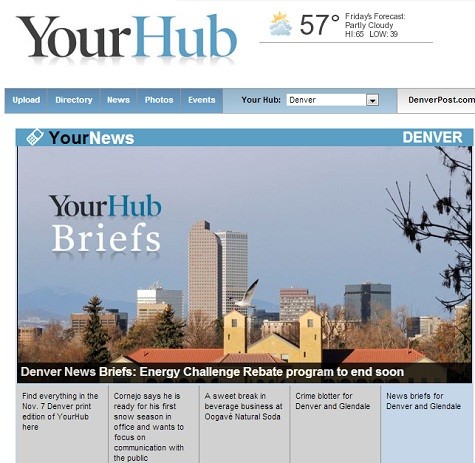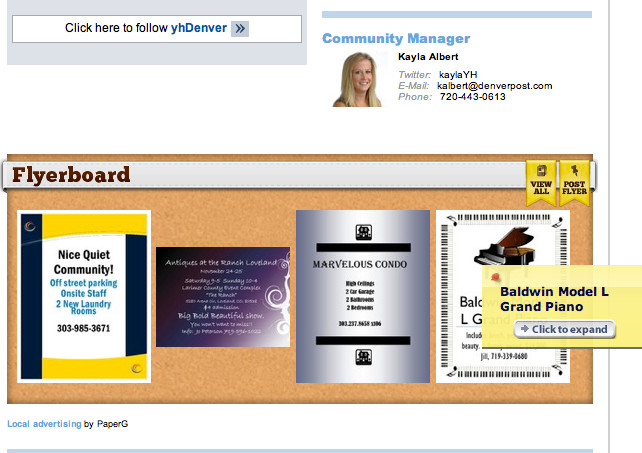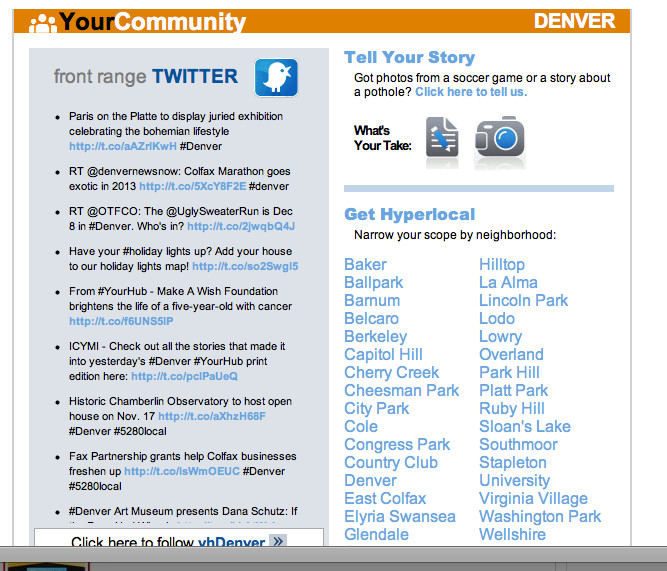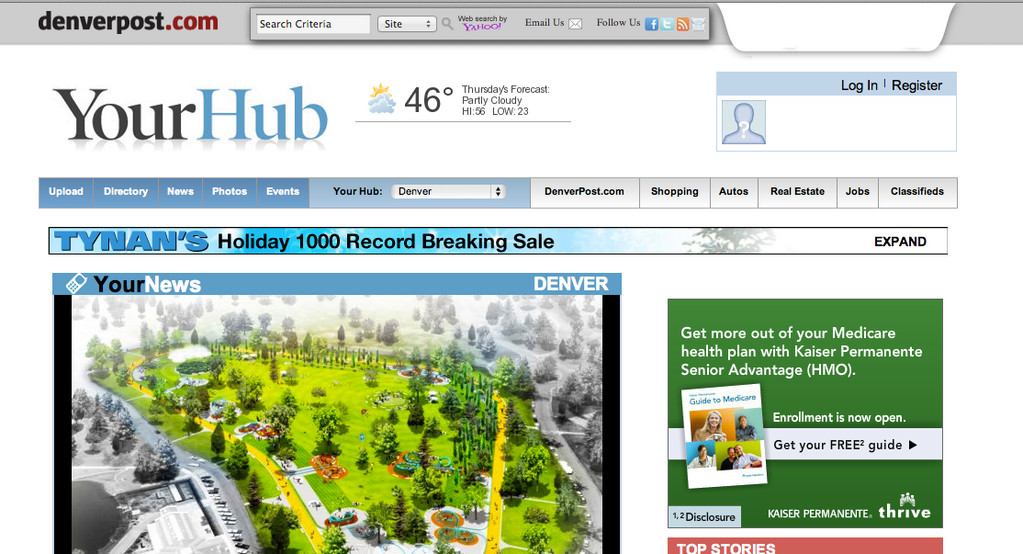The Denver Post's hyper-local YourHub yields solid profits, other benefits
Media: The Denver Post, Denverpost.com
Owner: MediaNews Group
Market: The six-county metro area of Denver, Colorado
Audience: 150,000 unique monthly online visitors
Contributors to this report: Chris Metteer, YourHub Managing Editor; Cathy Masek, Denver Post advertising director
Initiative: YourHub, a channel of nine hyper-local community-news sites and publications
Challenge: To create incremental revenues from hyper-local suburban sites with a combination of user-generated content, professional content and quality standards.
Strategy: The Denver Post’s YourHub was created in 2005 and the model has continually evolved into its current level. The sales team is smaller that it once was, but has learned new best practices, focusing on hyper-local accounts supplemented with self-entry advertising. The editorial teams have developed strong community relationships with writers and now serves as a feeding ground for the Denver Post newsroom. Here are the key components of YourHub:
Editorial staffing
YourHub's editorial staff is divided into five hyperlocal teams of three – a designer, editor and community manager.
Community managers train and oversee contributors, making sure they know and adhere to policies. Contributors are solicited via “post a story” forms on the site, and then coached by the managers.
When both leads and user-content come in via the website, editors and community managers are on the phone making contacts. The community managers make the first contact with the UGC people. Editors do business profiles and the community managers make first contact with those business people as well.
Assigning community managers to solicit free business profiles opens the door to community news stories and advertising leads. Each site also retains two Spanish-speaking community members, due to high local Latino population.
About 50% of the content is now user-generated. Here's an example of the initial form:
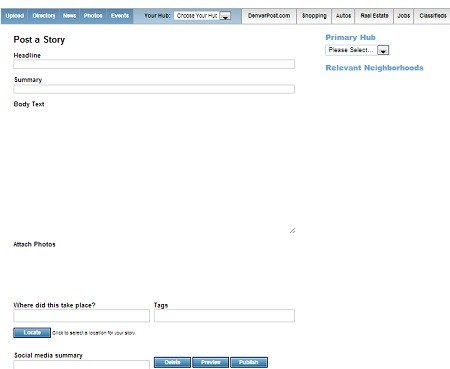
“We have a handful of regular contributors,” he said. “There’s one younger man who does movie reviews for all our publications, for instance. No, we don’t have to go out and hire talent. Talent comes to us.”
When the Post cut more than 70 percent of its news staff in 2011, YourHub's unpaid community contributors became even more important overall.
“YourHub has become much more of a news organization than what we originally planned,” Metteer told Local Media Insider.
“Half of our content comes from community contributors – that definitely helps retain our news volume. They contribute plenty of newsy stories our people can’t pick up – the opening of new restaurants, and smaller issues affecting their community. This is how YourHub has gotten its reputation as the kindly neighbor down the street. We get very friendly feedback.”
The Denver Post newsroom uses YourHub as newsroom training ground. Many new hires have been tapped from writers that emerged from the community.
Content distribution
In addition to publication on the web site stories are shared with Spanish-language sister publication. And the site is reverse published with 220,000 print copies home delivered.
Sales strategy
The site relies heavily on two dedicated advertising sales reps who sell YourHub-only packages to SMB’s whose neighborhood provides their key market for business and who can’t afford full Post advertising.
Denver Post advertising director Cathy Maser says this core sales team is what was left after reorganization of the department. One was originally hired as the YourHub sales manager, for a sales team of ten. A year later most of that team was absorbed into the local Post team. “We’ve gone through lots of expanding and contracting.“
Pricing and packaging
Packages focus on reaching an audience within a five mile zone of the local merchant. The key products are location-based community home page sponsorships or run of Hub banner ads.
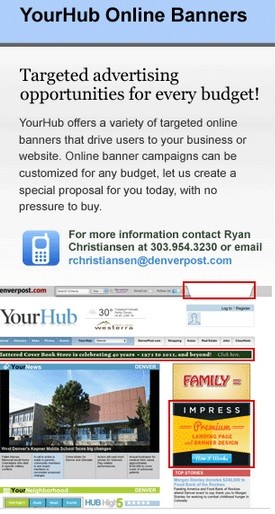 “YourHub is definitely a profitable bit of business for us,” Masek said. “Digital is difficult for small businesses. They don’t have the dollars to invest in a Post media campaign, so they do more of their branding on local websites like YourHub. Almost all of our advertisers are YourHub only; they’re not typically combo’d with Denver Post ads.”
“YourHub is definitely a profitable bit of business for us,” Masek said. “Digital is difficult for small businesses. They don’t have the dollars to invest in a Post media campaign, so they do more of their branding on local websites like YourHub. Almost all of our advertisers are YourHub only; they’re not typically combo’d with Denver Post ads.”
The screenshot to the right shows the online YourHub promo for banner advertising, and a sample banner ad.
"User-generated content drives advertising,” said Metteer.
“We get good support from the local parks and recreation department, and from non-profits. UCG gives them a sense of connection to the product.”
Maser says assumptive 52 week advertising commitments work well; with 26 and 13 week commitments sold only after 52-week is declined. 13 weeks is the minimum commitment. The typical sale is $500 to $660 a month, against a base rate of $10 to $12 CPM.
Advertisers are often later upsold to other Post products such as search, social-media advertising, and inserts.
There are also significant discounts - up to 50% - to advertisers for purchases of four or more zones.
YourHub also deploys Flyerboard, a self-serve ad unit that allows merchants to post “flyers” to a corkboard style unit, for $12 a week and up.
“We don’t actively sell Flyerboard except for classifieds,” Maser said.
“If you put your business on the Flyerboard then it will live on the home page of that community’s hub as part of a corkboard. It has an extremely low price point, however, and so we don’t ever sell it a la carte.”
Technology platform
The community site was built on a highly-customed version of Eidos Media’s Methode, the same program running the Washington Post, New York Post and Wall Street Journal websites. Kaango powers the advertising .
Results
• In 2012, five years after the inial launch, there are approximately 40 regular weekly advertisers, most of whom commit to at least four zones, for approximate incremental monthly ad revenue of $23,000.
“YourHub is definitely a profitable bit of business for us,” Masek said.
“Digital is difficult for small businesses. They don’t have the dollars to invest in a Post media campaign, so they do more of their branding on local websites like YourHub. Almost all of our advertisers are YourHub only; they’re not typically combo’d with Denver Post ads.”
• User-generated content drives advertising. “We get good support from the local parks and recreation department, and from non-profits. UCG gives them a sense of connection to the product.”
• Metteer called YourHub the “AAA farm team” for the Denver Post newsroom, explaining that YourHub staff articles are continually picked up by the Post. YourHub reporters sometimes get hired for Post positions when they come open, he said.
Lessons learned:
• in the user-generated model, contributors must be heavily-moderated early on and need ongoing go-to staff person. However, it has been possible to find many regular, quality contributors without having to compensate them
• News-staff pushback was not a concern as the stories UGC people contribute are different from ones paid staff typically chase.
• Smaller-ticket advertising items should be self-service, without costly marketing or time spent on sales efforts.

The author, Alisa Cromer is publisher of a variety of online media, including LocalMediaInsider and MediaExecsTech, developed while on a fellowship with the Reynolds Journalism Institute and which has evolved into a leading marketing company for media technology start-ups. In 2017 she founded Worldstir.com, an online magazine, to showcases perspectives from around the world on new topic each month, translated from and to the top five languages in the world.

